- English
- Sales & Support:0086 755 89315501 / 18688718622
| Place of Origin: | Shenzhen,China |
| Brand Name: | Rainbow Packaging |
| Certification: | ISO,FDA,SGS |
| Model Number: | Special Shape Bags-032 |
| Minimum Order Quantity: | 1000pcs |
|---|---|
| Price: | 0.08$-0.39$ |
| Packaging Details: | Child proof zipper,Hang hole,Tear notches,Window,Matt surfa |
| Delivery Time: | 3-5workdays by DHL To the USA |
| Payment Terms: | T/T;Paypal;Trade assurance via |
| Supply Ability: | 50000000pcs |
Die-cut bags are a type of packaging made from plastic or other flexible materials. They are manufactured by using a die-cutting process to create specific shapes or designs in the material. These bags are popular for a variety of applications due to their versatility and customization options.
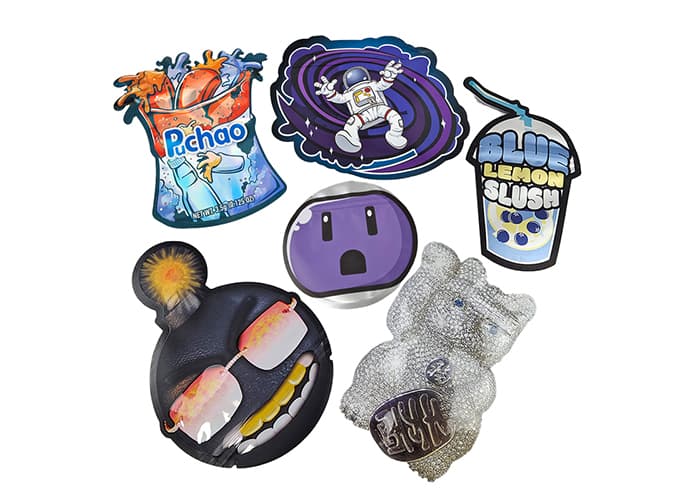 | 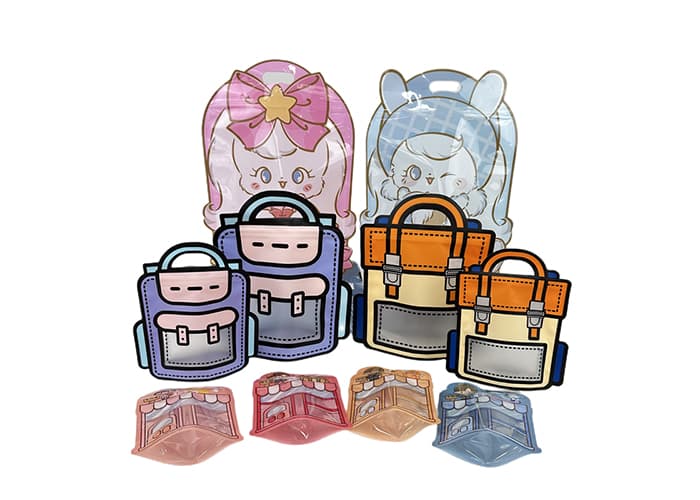 |
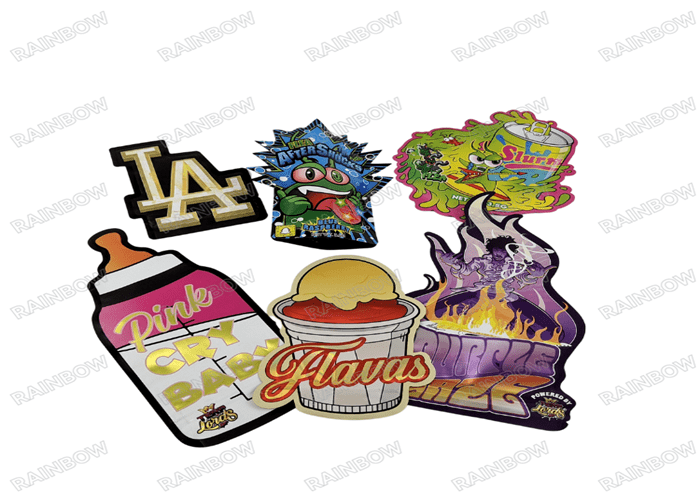 | 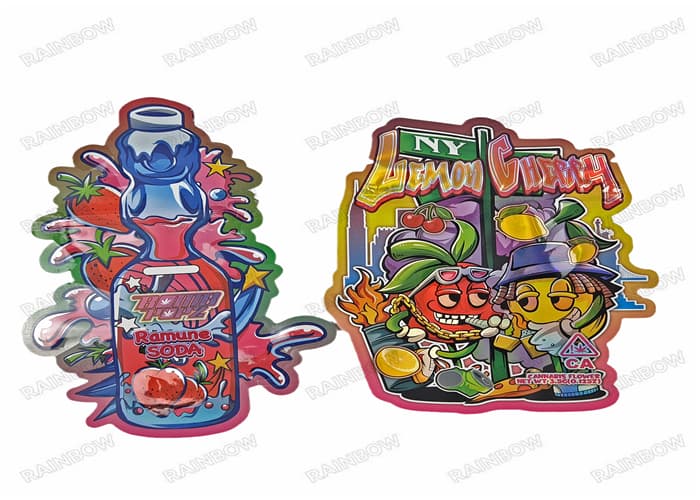 |
What is die cutting process? The die cutting process is a manufacturing technique used to cut, shape, and form materials into specific shapes or designs. It involves using a specialized tool, known as a die, to cut through materials such as paper, cardboard, fabric, foam, plastic, and more. Here's an overview of the die cutting process:
Design and Preparation:
Creating the Die:
Positioning the Material:
Die Cutting Process:
Removing Waste Material:
Inspecting and Quality Control:
Die cutting is widely used in various industries, including packaging, printing, textiles, automotive, electronics, and more. It is favored for its precision, speed, and ability to create intricate shapes efficiently.
The process can be performed manually using hand-operated die cutting machines or automatically with the use of computer-controlled machines for high-volume production. The choice of machine and die depends on factors like the material being cut, the complexity of the design, and the required production volume.
The die-cutting process allows for precise and intricate shapes to be created in the material, making it ideal for branding and promotional purposes. Die-cut bags can be used in retail for packaging products, as gift bags, or for promotional giveaways.
They are available in various sizes, colors, and materials, allowing businesses to choose options that best suit their needs. Additionally, die-cut bags are often more visually appealing and can create a distinctive look for a brand.
Overall, die-cut bags are a versatile and customizable packaging option that can be tailored to specific branding and promotional requirements.
| CUSTOM ORDER: | Accept | COLOR: | Colorful |
| SAMPLE: | Avaialble | THICKNESS: | 50-200microns |
| MATERIAL: | Food Grade Material | SIZE: | Customized Size |
| FEATURE: | Moisture Proof,Recyclable,Security | INDUSTRIAL USE: | Candy,Cookie,Gummy Food Packaging |
| High Light: | Die cut bags |
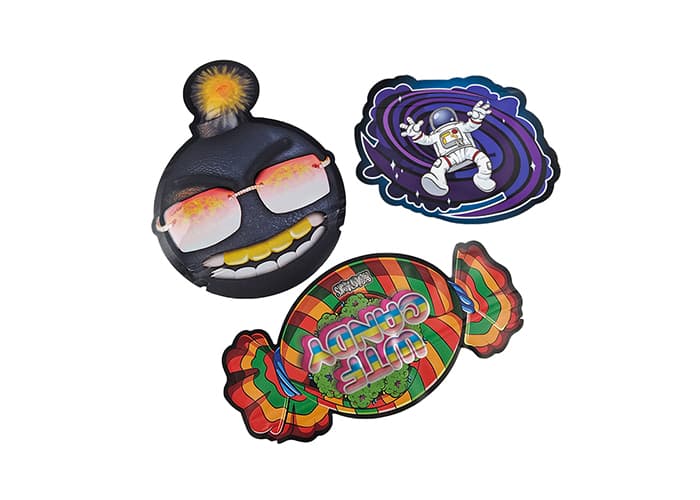 | Welcome to our website www.diecutpouch.com, we are a professional packaging bags supplier with our own modern automatic packaging bags factory which contains efficient production line. As a leading packaigng bags manufacturer we can provide many different types of packaging bags wholesale and customize, especially in producing die cut bags more than 15 years experience. So if we are your die cut bags business partner, what we can de for you, the follows are the die cut bags we can custom and design for you |
Die cut bags classified by material
| Die cut bags classified by shapes
| Die cut bags classified by types
|
Die cut bags classified by colors
| Die cut bags classified by sizes
| Die cut bags classified by applications
|
Die cut bags classified by features
| Die cut bags classified by printing
| Die cut bags classified by eco friendly
|
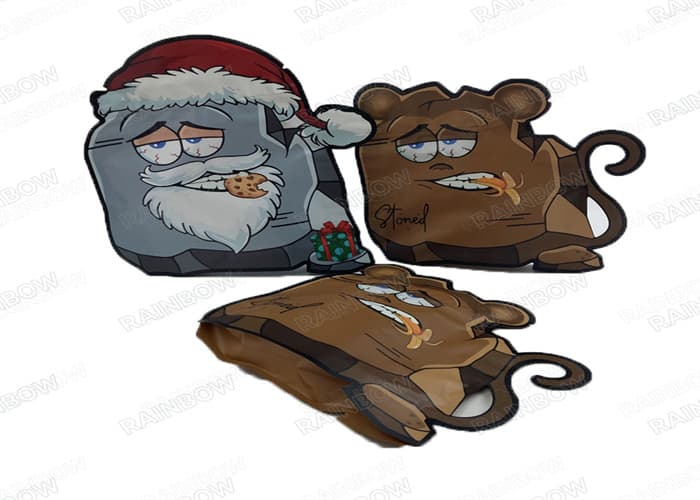 | 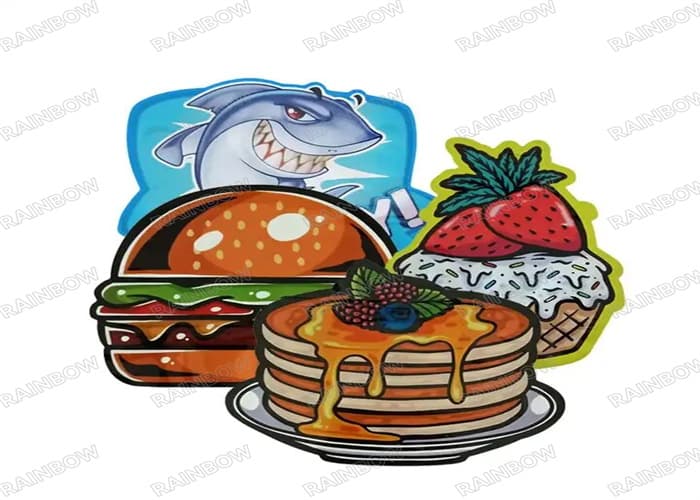 |
Material of die cut bags | Colors of die cut bags | Types of die cut bags |
Shapes of die cut bags | Sizes of die cut bags | Printing of die cut bags |
Applications of die cut bags | Process of die cut bags | Features of die cut bags |
Advantages of die cut bags | Benefits of die cut bags | Customization of die cut bags |
Technology of die cut bags | Market trends of die cut bags | Eco friendly of die cut bags |
| Type | Features | Suitable Applications |
|---|---|---|
| Paper Die Cut Bags | - Environmentally friendly, recyclable | - Retail Shopping |
| Plastic Die Cut Bags | - Durable, waterproof | - Heavy-duty Items, Packaging in Wet Environments |
| Non-Woven Die Cut Bags | - Reusable, eco-friendly | - Promotional Events, Advertising Giveaways |
| Biodegradable Die Cut Bags | - Naturally degrades, eco-friendly | - Eco-friendly Events, Short-term Packaging |
| Fabric Die Cut Bags | - Reusable, made from high-quality fabric | - High-end Gifts, Fashion Packaging |
| Kraft Paper Die Cut Bags | - Sturdy, eco-friendly | - Crafts Packaging, Specialty Item Display |
| Tyvek Die Cut Bags | - High strength, waterproof, durable | - Items Requiring High Protection (Medical, Industrial) |
| Jute Die Cut Bags | - Natural material, eco-friendly | - Personalized Gifts, Tote Bags |
| Canvas Die Cut Bags | - Durable, reusable | - Shopping Bags, Promotional Bags, Eco-friendly Bags |
| Polypropylene Die Cut Bags | - High strength, durable | - Tote Bags, Retail Bags |
| PVC Die Cut Bags | - Transparent, waterproof | - Retail Packaging, Gift Packaging |
| Color | Description |
|---|---|
| White | Clean and versatile, suitable for various occasions. |
| Brown | Natural and eco-friendly, often associated with organic products. |
| Black | Elegant and sophisticated, ideal for luxury brands or events. |
| Clear | Transparent, perfect for showcasing contents, commonly used in retail. |
| Red | Energetic and vibrant, often used for special occasions or holidays. |
| Blue | Professional and reliable, suitable for business or formal settings. |
| Green | Associated with nature, health, and eco-friendliness. |
| Yellow | Represents joy and positivity, great for promotions and celebrations. |
| Orange | Vibrant and warm, linked to creativity and innovation. |
| Purple | Conveys luxury and mystery, suitable for high-end brands or occasions. |
| Pink | Often associated with femininity and romance. |
| Metallic | Shiny and reflective, adds a touch of luxury and glamour. |
| Pastel | Soft, muted tones that evoke a sense of calm and serenity. |
| Neon | Bright, attention-grabbing colors, perfect for high-impact designs. |
| Gold | Symbolizes wealth, luxury, and prestige. |
| Silver | Represents elegance, sophistication, and modernity. |
| Bronze | Evokes a sense of antiquity and classic charm. |
| Teal | Combines the calming properties of blue with the renewal qualities of green. |
| Burgundy | Rich, deep red with a touch of brown, associated with luxury and opulence. |
| Navy Blue | Classic and timeless, often used for a professional and polished look. |
| Forest Green | Dark, earthy green associated with nature and the outdoors. |
| Lavender | Delicate and soothing, often used for products related to relaxation. |
| Turquoise | Calming and refreshing, reminiscent of tropical waters. |
| Maroon | Deep, reddish-brown color, often linked to elegance and sophistication. |
| Olive Green | Represents peace and nature, often used in eco-friendly contexts. |
| Charcoal Gray | Sleek and modern, conveys professionalism and sophistication. |
| Beige | Neutral and versatile, complements a wide range of styles and themes. |
| Cream | Soft and inviting, gives a sense of warmth and comfort. |
| Type of Die Cut Pouch | Description | Applications | Key Features |
|---|---|---|---|
| Flat Die Cut bags | Basic flat rectangular pouch with die-cut edges | Small items, snacks, powders, lightweight products | Cost-effective, space-efficient packaging |
| Gusseted Die Cut bags | Pouch with expandable sides or "gussets" | Bulky or larger items | Increased volume capacity, improved product display |
| Stand-Up Die Cut bags | Pouch with a bottom gusset for vertical display | Retail packaging, pet food, snacks, liquids | Convenient vertical presentation, shelf space utilization |
| Ziplock Die Cut bags | Pouch with a resealable ziplock closure | Snacks, nuts, small hardware items | Easy opening and resealing, product freshness |
| Windowed Die Cut bags | Pouch with a transparent window or panel | Food products, visually appealing items | Enhanced product visibility, strategic product showcase |
| Vacuum Seal Die Cut bags | Pouch designed for vacuum sealing | Perishable items such as meat, seafood | Extended shelf life, preservation of product quality |
| Retort Die Cut bags | Pouch designed for high-temperature processing | Ready-to-eat meals, long-shelf-life products | Withstands high heat processing, product integrity |
| Kraft Paper Die Cut bags | Pouch made from eco-friendly kraft paper | Organic and eco-friendly products | Biodegradable, natural and rustic appearance |
| Printed Die Cut bags | Pouch with custom printing and branding | Promotional and retail packaging | Personalized and attractive packaging, brand visibility |
| Shape | Description |
|---|---|
| Square | Four equal sides and angles, providing a clean, symmetrical look. |
| Rectangle | Longer sides and shorter sides, creating a classic, versatile shape. |
| Round | Circular shape, offering a soft and pleasing aesthetic. |
| Oval | Elliptical shape, providing a unique and eye-catching appearance. |
| Heart | Symbolic shape representing love and affection. |
| Star | Distinctive shape often associated with achievement and excellence. |
| Customized | Any shape that is specially designed to fit specific branding or thematic requirements. |
| Trapezoid | A four-sided shape with two parallel sides, adding visual interest. |
| Hexagon | Six-sided polygon, conveying a modern and dynamic look. |
| Pentagon | Five-sided polygon, offering a balanced and distinctive appearance. |
| Irregular | A shape that deviates from standard geometric forms, providing a unique, artistic touch. |
| Size | Description |
|---|---|
| Small | Suitable for small items, easy to carry. |
| Medium | Standard size, versatile for various uses. |
| Large | Larger capacity, suitable for accommodating bigger items. |
| Extra Large | Very large capacity, ideal for large or multiple items. |
| Mini | Extremely small size, suitable for small gifts or giveaways. |
| Jumbo | Larger than standard large size, for special or bulky items. |
| Custom | Tailored to specific requirements, meeting brand or product needs. |
| Die cut bags can be customized with various types of printing to convey specific messages, branding, or visual aesthetics. Here are some common printing options for die cut bags:
The choice of printing method depends on factors like brand identity, target audience, and the intended use of the die cut bags. Each option offers its own unique visual impact and can be tailored to meet specific marketing or branding goals |
Die cut bags find applications in a wide range of industries and scenarios due to their versatility and customizable nature. Here are some common applications of die cut bags:
Retail Stores: Die cut bags are widely used in retail environments to package and carry purchased items. They can be customized with store logos and branding for a professional look.
Grocery Stores: Often used for packaging fruits, vegetables, and other grocery items. They can be made from eco-friendly materials to promote sustainability.
Promotional Events: Customized die cut bags are popular as promotional giveaways at events, trade shows, and conferences. They serve as a tangible reminder of the brand.
Gift Shops: Die cut bags are an excellent choice for packaging gifts, providing an aesthetically pleasing and convenient way to present items.
Boutiques and Fashion Stores: High-quality die cut bags add a touch of sophistication to the shopping experience, especially in the fashion and luxury goods industry.
Restaurant Takeout: Die cut bags are used for packaging takeout orders, providing a convenient and stylish way to carry food.
Bakery and Pastry Shops: Ideal for packaging baked goods, allowing for easy transportation without compromising the product's quality.
Pharmacies: Die cut bags are used to package prescription medications, health products, and over-the-counter items.
Apparel Stores: These bags are commonly used to package clothing items, providing a stylish and branded packaging solution.
Specialty Stores (e.g., Jewelry, Cosmetics): Die cut bags can be customized to suit the specific needs of specialty stores, adding an extra layer of value to the customer's experience.
Advertising Campaigns: Companies often use die cut bags as part of their advertising campaigns. Branded bags with eye-catching designs help increase brand visibility.
Merchandise Sales at Events: Die cut bags are used to package and carry merchandise sold at events such as concerts, festivals, and sporting events.
Tote Bags: Larger die cut bags with handles are commonly used as reusable tote bags, providing a sustainable alternative to plastic bags.
Environmental Initiatives: Biodegradable and eco-friendly die cut bags are used in campaigns and initiatives to promote sustainability.
Trade Shows and Conventions: Die cut bags with customized branding are distributed to visitors and attendees, serving as a practical keepsake.
These are just some of the many applications of die cut bags, highlighting their versatility and adaptability to various industries and marketing purposes.
The process of manufacturing die cut bags involves several steps. Here's an overview:
It's important to note that the exact process can vary based on factors such as the type of material used for the bags, the printing technology employed, and any additional customization requested by the client. Additionally, eco-friendly practices, such as using recyclable materials or water-based inks, may be integrated into the process to align with sustainability goals |
|
Die cut bags offer a range of features that make them versatile and appealing for various applications. Here are some common features of die cut bags:
Customizable Shape: Die cut bags can be cut into various shapes, allowing for unique and eye-catching designs that align with branding or specific requirements.
Material Variety: They can be made from a wide range of materials, including paper, plastic, non-woven fabric, and more, providing options for different purposes and preferences.
Handle Options: Die cut bags can be designed with handles, which can be made of materials like paper, rope, fabric, or plastic. Handles add convenience and ease of carrying.
Printability: Die cut bags can be easily customized with branding, logos, graphics, and text using different printing methods, allowing for a personalized and professional appearance.
Sustainability Options: Eco-friendly and biodegradable materials can be used to create environmentally-conscious die cut bags, aligning with sustainability goals.
Various Sizes: They come in a range of sizes, from small to extra-large, providing options for different products and quantities.
Gussets and Folds: Some die cut bags have gussets or folds that allow for expansion, providing additional capacity for larger or bulkier items.
Durable Construction: Depending on the material used, die cut bags can offer durability and strength, ensuring they can handle the weight of the contents.
Special Finishes: Options like lamination, embossing, or coatings can be applied to enhance the look and feel of the bags, adding a touch of luxury or texture.
Clear Windows (if applicable): For certain applications, die cut bags can include clear windows or panels to showcase the contents without the need to open the bag.
Tear-Resistant: Depending on the material and construction, die cut bags can be designed to resist tearing or damage during use.
Water-Resistance (if applicable): Some materials used in die cut bags can be treated to provide a level of water-resistance, protecting contents from moisture.
Recyclable/Compostable Options: Eco-conscious consumers and businesses can opt for die cut bags made from materials that are recyclable or compostable.
Cost-Effective Packaging: Die cut bags can often be produced at a relatively low cost, making them an economical choice for businesses of various sizes.
These features make die cut bags a versatile and customizable packaging solution suitable for a wide range of industries and purposes. Depending on specific needs and preferences, businesses can choose the features that align with their branding and functional requirements.
Advantages of die cut bagsDie cut bags offer several advantages that make them a popular choice for packaging solutions. Here are some of the key advantages of using die cut bags:
These advantages make die cut bags an attractive option for businesses looking for customizable, cost-effective, and versatile packaging solutions. They can enhance branding efforts, improve customer experience, and contribute to overall business success. | Benefits of die cut bagsDie cut bags offer a range of benefits that make them a popular choice for packaging solutions across various industries. Here are some of the key benefits of using die cut bags:
These benefits make die cut bags an attractive option for businesses looking for customizable, cost-effective, and versatile packaging solutions. They can enhance branding efforts, improve customer experience, and contribute to overall business success. |
| Customization is a key feature of die cut bags, allowing businesses to create unique and branded packaging solutions. Here are some aspects of die cut bags that can be customized:
By offering such a wide range of customization options, die cut bags provide businesses with a versatile and effective packaging solution that can be tailored to their specific branding and functional needs |
The technology behind die cut bags involves a combination of design, printing, and manufacturing processes. Here's an overview of the technology used in producing die cut bags:
Design Software: The process starts with the use of specialized design software to create the artwork and layout for the die cut bag. This software allows for precise control over dimensions, graphics, and text placement.
Prepress and Color Separation: The finalized design is prepared for printing through prepress operations. This may involve tasks like color separation, where the design is broken down into individual color plates for printing.
Printing Methods:
Flexographic Printing: Commonly used for die cut bags, this method involves a flexible printing plate with raised images that is pressed onto the bag material. It's suitable for high-volume production.
Offset Printing: A more traditional printing method, offset printing transfers ink from a plate to a rubber blanket before applying it to the bag material. It's known for high-quality results.
Digital Printing: Utilizes digital technology to directly print the design onto the bag material. It's suitable for short runs and allows for high-resolution printing.
Die Cutting Machine: This machine uses a custom-made steel blade, known as a die, to cut the bag material into the desired shape. The die is created to match the specific dimensions and shape of the bag.
Handle Attachment (if applicable): If the die cut bags are designed with handles, a separate process may be used to attach them securely to the bag.
Folding and Gluing (if applicable): Some die cut bags may undergo folding or gluing processes to create specific configurations, like gusseted bottoms or flaps.
Quality Control and Inspection: Finished die cut bags go through quality control checks to ensure they meet specified standards. This includes checking for any printing imperfections, misalignment, or other defects.
Optional Finishing Touches:
Lamination: A thin protective layer is applied to the surface of the bag to enhance durability and appearance.
Embossing or Debossing: A design is raised (embossed) or recessed (debossed) on the bag's surface, creating texture and visual interest.
Coatings: Special coatings can be applied for effects like gloss, matte, or special textures.
Packaging and Shipping: Once the bags pass inspection, they are bundled, packaged, and prepared for shipping to the client or distribution center.
Optional Sustainable Practices: Manufacturers may incorporate eco-friendly practices, such as using recyclable materials or water-based inks, to align with sustainability goals.
By combining these various technologies, manufacturers are able to produce customized, high-quality die cut bags that meet the specific requirements and branding goals of businesses across different industries.
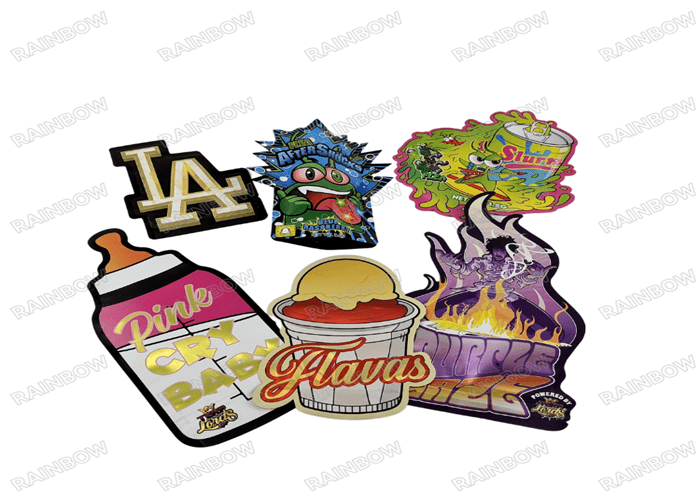
As of my last knowledge update in September 2021, several market trends were influencing the die cut bag industry. However, please note that for the most current information, you should refer to the latest industry reports or news sources. Here are some trends that were prevalent in 2021:
Sustainability and Eco-Friendly Materials:
Customization and Branding:
Online Retail and E-Commerce:
Retail Experience Enhancement:
Emphasis on Versatility:
Innovative Printing Techniques:
Rise of Boutique and Specialty Stores:
Regulatory Compliance:
COVID-19 Impact:
Global Supply Chain Challenges:
It's important to note that market trends can change over time due to factors like consumer preferences, industry innovations, and economic shifts. For the most current information, it's advisable to consult up-to-date industry reports and market analyses.
| Eco-friendly die cut bags are designed to have minimal environmental impact throughout their lifecycle. They are made from materials that are sustainable, biodegradable, recyclable, or compostable. Here are some key aspects of the eco-friendliness of die cut bags:
It's important to note that the eco-friendliness of a die cut bag depends on factors such as the specific material used, its sourcing, and the disposal methods available in a given area. For businesses seeking eco-friendly packaging solutions, it's advisable to work with reputable suppliers and verify certifications or claims regarding the environmental attributes of the bags |
1. What are Die Cut Bags?
2. Which industries typically use Die Cut Bags?
3. Can Die Cut Bags be customized?
4. Are Die Cut Bags environmentally friendly?
5. What materials are commonly used for Die Cut Bags?
6. What printing methods are used for Die Cut Bags?
7. How can Die Cut Bags enhance brand visibility?
8. What are the benefits of using eco-friendly Die Cut Bags?
9. How can Die Cut Bags improve the retail experience?
10. What are some optional finishes for Die Cut Bags?
11. How can Die Cut Bags contribute to a circular economy?
12. Are there regulations regarding eco-friendly packaging?
13. What handle options are available for Die Cut Bags?
14. Can Die Cut Bags be used for online retail?
15. How can Die Cut Bags be used for promotional events?
16. What are some innovative printing techniques for Die Cut Bags?
17. How can Die Cut Bags be used in the food service industry?
18. Can Die Cut Bags be used in specialty stores?
19. What are the advantages of using Die Cut Bags for branding?
20. How can Die Cut Bags contribute to reducing single-use plastics?
Address: 5th Floor, Building 6, No.23, Xinbao Second Street, Dalang Town, Dongguan,523786,Guangdong,China. Die cut pouch, die cut bag on sales from our die cut pouch factory, professional die cut bag manufacturer provide die cut pouch, die cut bag, custom die cut bags wholesale and designs